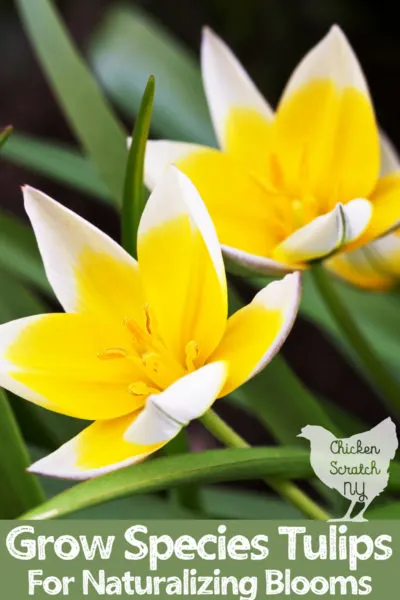For a long time I thought I was a tulip failure. Despite my best efforts the bulbs I planted would flower beautifully the first year and then dwindle until I had only a handful of blooms from 100’s of supposedly perennial bulbs.

I picked up 100 of their species tulip mix for my front garden to replace the defunct Appledoorn tulips. I thought I’d share what I’ve learned about these pretty spring bloomers.
These beauties are the wild ancestors of the modern Dutch tulip varieties. Like most wild ancestors they are much hardier than their modern counterparts.
Species Tulips are truly perennial and are known to naturalize under the right conditions. They do best in well draining rocky soil where the bulbs won’t get waterlogged.
They’ve come back for a few years now but I think the area they’re in is too wet. I’m going to try again in another area that actually has some drainage, maybe with the daylilies. They seem to thrive on benign neglect, my favorite type of garden plant.
They should get sun while blooming, which then do with the other tulips in the early spring. They can be planted under trees, by the time the tree leafs out the tulips have faded away. It’s best to leave the foliage alone after blooming so plant them somewhere you won’t want to mow right away or at all.
Unlike the large tulips we’re all used to they don’t have very large leaves. The foliage blends in pretty well and won’t be as distracting as the lingering leaves left behind by modern tulips.
The flowers look like tulips, sort of, if you squint. Once you know they’re tulips you’ll recognize the similarities but you might not get there on your own. The flowers are more open and less cup shaped. The flower petals tend to be pointy.
Species tulips are available in many colors, from bright orange-red to white with pale lavender centers. Some varieties have single flowers while other put up multiple blooms.
Compared to modern tulips they are on the small size. They seem to max out at 12 inches tall but many types are shorter, some only 4 inches. The size makes them perfect for mass plantings, rock gardens and inter-planting in borders.
They’re also super cheap! I picked up 100 mixed bulbs for a little more than $16. For perspective 100 mixed Giant Darwin tulips are $35 from the same supplier. And these come back! (I’m still stuck on that if you couldn’t tell). Some types are a little more expensive but that’s how it goes.
If you’re interested in more about wild tulips check out the site Tulips in the Wild for gorgeous, scenic photography and more tulip information than you ever thought possible.
Check out my Garden page for more ideas or start here:









Heidi @ Pint Size Farm
Monday 13th of October 2014
Wow! Those are absolutely beautiful.